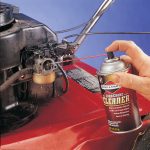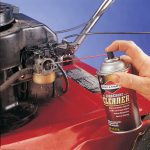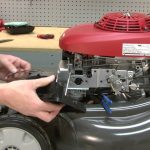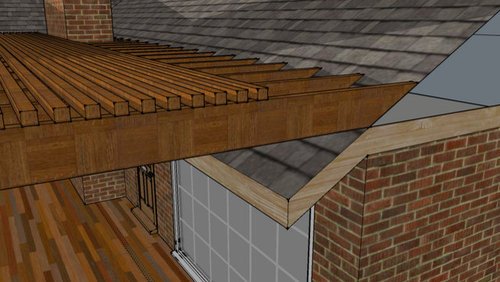Yes, some lawn mower blades have reverse threads. This is important to know when removing and replacing the blades on your mower.
Lawn mowers are essential tools for keeping your garden trimmed and looking neat. However, like any machine, they require maintenance to keep them working effectively.
One key aspect of this maintenance is replacing the blades. It’s important to know if your lawn mower blade has a reverse thread as this will ensure that you properly remove it without damaging the machine.
In this article, we will discuss why some lawn mower blades have reverse threads, the benefits of using reverse threads, and how to remove and replace them properly.
So, let’s dive in and learn more about lawn mower blades with reverse threads.

Credit: www.amazon.com
Understanding Lawn Mower Blades
Are Lawn Mower Blades Reverse Thread? Understanding Lawn Mower Blades
Lawn mower blades play an essential role in maintaining a healthy and attractive lawn. Over time, blades can become dull, damaged, or even detached from the mower. Whether you are a first-time lawn mower user or an experienced professional, it is crucial to understand lawn mower blades’ workings, types, and importance.
Read on to learn more.
The Importance Of Lawn Mower Blades
Lawn mower blades are responsible for cutting grass blades evenly and keeping the lawn healthy. A sharp, well-maintained blade ensures that grass is cut uniformly, reducing the risk of damage to the lawn by pests and diseases. On the other hand, dull blades cause the grass to be torn, leaving grass blades jagged and increasing the likelihood of diseases and pest infestation.
Types Of Lawn Mower Blades
Different types of lawn mower blades are available to suit various mowing needs.
- Straight blade – best suited for mowing lush and thick grass.
- Mulching blade – cuts and mulches grass blades into small pieces, making them easier to decompose and return essential nutrients to the lawn.
- Gator blade – features serrated teeth, ideal for mowing tall and dense grass. It also improves the overall mowing efficiency.
How Lawn Mower Blades Work
Lawn mower blades’ working mechanism involves a process of air circulation, vacuum created under the mower deck, and cutting action. As the blades spin, they lift the grass blades, which are then cut by the sharp edge of the blade.
The air circulation caused by the blade’s spinning creates a vacuum that pushes the cut grass up into the mower deck bag or onto the lawn.
Common Problems With Lawn Mower Blades
Regular maintenance and inspection of lawn mower blades is essential to ensure their effectiveness and longevity.
- Dull blades – over time, lawn mower blades tend to become dull, leading to poor cutting performance.
- Bent blades – mowing over hard or heavy objects may bend the blade’s edges, causing uneven cuts and creating vibration during mowing.
- Damaged blades – rocks or any hard objects may damage lawn mower blades, which require immediate replacement.
- Loose blades – loose or poorly installed blades can cause vibration during the mowing process, leading to the blade’s premature wear and damage.
Lawn mower blades are an essential component of the mowing process. Understanding the different types, their working mechanisms, and their importance can help maintain a healthy and attractive lawn. Regular maintenance and inspection of lawn mower blades go a long way in ensuring their optimal performance.
The Concept Of Reverse Threads
As a lawn owner, maintaining your lawn and keeping it neat and tidy is essential for a healthy and beautiful yard. You need to ensure that you mow your lawn regularly, but to do so, you need a functional lawn mower with proper blades.
If you’re a new lawn owner or you’re simply wondering about your lawn mower blade’s threads, you might be wondering whether lawn mower blades are reverse-threaded. In this article, we’ll explore the concept of reverse threads, how they work, and when they are used.
What Are Reverse Threads?
When it comes to discussing lawn mower blades, we need to differentiate between regular and reverse threads. Regular threads follow a right-handed pattern, meaning they loosen in a counterclockwise motion and tighten clockwise. Reverse threads, on the other hand, follow a left-handed pattern.
This means they loosen in a clockwise motion and tighten counterclockwise.
How Do Reverse Threads Work?
Reverse-threaded lawn mower blades work in the same way as regular blades but with reversed directional screws. When you install or remove reverse-threaded blades, you’ll have to turn them clockwise to loosen and counterclockwise to tighten. This process is the opposite of installing or removing regular-threaded blades.
When removing the blade, be sure to secure the lawn mower blade holder in place with a block of wood to avoid rotating the sharp blades into your hand.
When Are Reverse Threads Used?
Reverse threads are used in various applications where the blades would rotate clockwise, such as lawn mowers, brush cutters, and circular saws. Lawn mower blades are commonly reverse-threaded for safety purposes. This is done so that the blade remains tight while the mower is in use, preventing it from unwinding and potentially causing injury.
The reverse threading ensures that the rotational force of the blade keeps the bolt tight rather than loosening it.
Reverse-threaded lawn mower blades are a crucial safety feature for lawn owners. It is essential to remember that these blades require a reverse turning motion to remove or install them. Understanding the concept of reverse threads and following the correct procedures when removing and installing blades on your lawn mower can ensure the safety of yourself and your mower.
Lawn Mower Blade Threads
For any avid gardener or lawn enthusiast, maintaining a well-kept lawn is an essential task. Lawn mowers work hard to keep the grass healthy and lush, but like any other mechanical equipment, they require maintenance. One common question that arises among lawn mower owners is whether lawn mower blades are reverse thread.
This blog post will explore lawn mower blade threads, the different types of threads on lawn mower blades, how to identify the thread direction on lawn mower blades, and the types of bolts used in lawn mowers.
The Different Types Of Threads On Lawn Mower Blades
Lawn mower blades can have two different types of threads- standard threads and reverse threads. Standard thread blades rotate clockwise to tighten and counterclockwise to loosen. On the other hand, reverse thread blades rotate counterclockwise to tighten and clockwise to loosen.
It’s important to know which type of thread your lawn mower blade has, as it can affect blade installation and removal.
How To Identify The Thread Direction On Lawn Mower Blades
Identifying the thread direction of a lawn mower blade is a simple process. Firstly, ensure your lawn mower is switched off, and you have access to the blade. Carefully examine the center of the blade to determine the thread direction.
Standard threads have a protruding middle section and rotate clockwise to tighten and counterclockwise to loosen. Reverse threads have the opposite – a recessed middle section and rotate counterclockwise to tighten and clockwise to loosen.
Types Of Bolts Used In Lawn Mowers
There are two common types of bolts used to secure the blade to the lawn mower – a regular bolt and a shoulder bolt. A regular bolt can be used with standard thread blades, and the tightening process is straightforward.
However, using a regular bolt on a reverse thread blade can cause irreversible damage to the lawn mower engine. A shoulder bolt is specifically designed for use with reverse thread blades, and it’s an important safety feature for lawn mower engines.
Understanding the different types of threads on lawn mower blades, knowing how to identify the thread direction on lawn mower blades, and using the correct bolts for the blade is essential for lawn mower maintenance. Regular maintenance can extend the life of your lawn mower, ensuring it continues to work hard to keep your lawn looking healthy and beautiful.
Reverse Threads On Lawn Mower Blades
Are Lawn Mower Blades Reverse Thread
Lawn mowers remain an essential equipment used in maintaining a lawn’s aesthetic value. One of the frequently asked questions amongst lawn mower owners is whether lawn mower blades have reverse threads. In this article, we will answer this question and provide information regarding the use of reverse threads on lawn mower blades, as well as how to remove them using suitable methods.
Do Lawn Mower Blades Have Reverse Threads?
Lawn mower blades have threads that fasten them to the machine, and the vast majority of lawn mower blades do not have reverse threads. Most lawn mower blades have regular threads that screw on clockwise (righty tighty). However, certain brands may provide mower blades with reverse threads, so before removing the blade, it’s essential to verify the blade’s threading.
Why Are Reverse Threads Used On Lawn Mower Blades?
Reverse threads, or left-hand threads, are frequently used to secure attachments in situations where the bolt or nut might come loose. This application is common in lawn mowers, preventing the blade from loosening and detaching. The use of a reverse thread on the mower blade enables the centrifugal force created from the turning of the blade to tighten the nut, providing extra stability.
How To Remove Lawn Mower Blades With Reverse Threads
Removing a lawn mower blade with reverse threads can be challenging, as it requires a different approach than a regular blade.
- Disconnect the spark plug cable and tilt the machine to access the blades’ bolts.
- Mark one end of the blade to know which direction to reinstall later.
- Use an appropriate mower blade wrench to loosen the nut in an anti-clockwise (lefty tighty) direction.
- Once you have loosened the nut, remove it and withdraw the blade from the mower.
- Inspect the blade for wear and damage.
- Install the new or sharpened blade in the direction of the arrow and tighten the nut firmly until the blade is secure.
Lawn mower blades rarely have reverse threads. However, it is critical to check the threading before attempting to remove them. Left-hand threads, or reverse threads, are used to ensure that the blade is stable while in use, with centrifugal force helping the nut’s tightening.
When removing mower blades with reverse threads, ensure you have an adequate wrench and follow the steps provided above to stay safe.
Tips For Maintaining Lawn Mower Blades
Are you tired of your lawn mower blades dulling faster than you can cut your grass? Many people overlook maintaining their lawn mower blades, but it’s a crucial step in keeping a healthy lawn. Keeping your blades sharp and clean can not only save you time and money in the long run, but it can also prevent your lawn from getting damaged.
In this section, we’ll explore some tips for maintaining lawn mower blades.
How To Prevent Blades From Dulling
Preventing your lawn mower blades from dulling is much easier than having to sharpen them later.
- Only mow dry grass: wet grass can be tough on your blades and cause them to dull quickly. It’s always best to mow when the grass is dry.
- Check for debris: before mowing your lawn, check for any debris such as rocks or twigs that might damage your blades. Running over debris can quickly cause your blades to dull.
- Adjust cutting height: mowing the grass too short can cause your blades to wear out faster. Adjust your cutting height accordingly to prevent your blades from working too hard.
How Often To Sharpen Lawn Mower Blades
Sharpening your lawn mower blades is essential to keep your grass healthy and prevent the blades from dulling. But how often should you sharpen them?
- Sharpen your blades at least once a year: sharpening your lawn mower blades at least once a year can help prevent them from dulling quickly.
- Check for signs of dullness: if you notice your lawn isn’t being cut evenly or you’re seeing brown spots, it might be time to sharpen your blades.
- Check your blade’s condition: if your blades have any nicks or chips, it’s best to sharpen them right away. Damaged blades can cause uneven cutting and damage to your lawn.
Importance Of Cleaning Lawn Mower Blades
Mowing your lawn can leave behind debris and grass clippings, which can turn into a breeding ground for bacteria and pests. Cleaning your lawn mower blades after each use can help prevent these issues and extend the life of your blades.
- Turn off the mower: turn off your lawn mower and make sure it’s unplugged before starting to clean.
- Remove debris: use a brush or scraper to remove any debris and grass clippings stuck on the blades.
- Wipe blades clean: use a rag and some soapy water to clean the blades. Make sure to dry them thoroughly before storing the mower.
Techniques For Keeping Lawn Mower Blades In Good Condition
Keeping your lawn mower blades in good condition can prevent them from dulling quickly and save you time and money in the long run.
- Store your lawn mower properly: keep your lawn mower in a dry area to prevent rust, and make sure to cover it when not in use.
- Use high-quality fuel: using low-quality fuel can cause damage to your lawn mower’s engine, which can affect your blades. Use high-quality fuel to prevent engine damage.
- Replace damaged blades: if you notice your blades are severely damaged or worn, it’s best to replace them. Using damaged blades can cause more harm than good to your lawn.
Maintaining your lawn mower blades is just as important as mowing your lawn. By following these tips, you can prevent your blades from dulling quickly, keep them clean, and extend their lifespan. Always remember to prioritize blade maintenance to keep your lawn healthy and looking great.
Frequently Asked Questions Of Are Lawn Mower Blades Reverse Thread
1. Do All Lawn Mower Blades Have A Reverse Thread?
No, not all lawn mower blades have a reverse thread. Some blades have a standard thread, while others have a reverse thread.
2. How Can I Identify If A Lawn Mower Blade Has A Reverse Thread?
To identify if a lawn mower blade has a reverse thread, check the direction of the blade’s rotation. If the blade rotates counterclockwise, it has a reverse thread.
3. What Is The Purpose Of A Reverse Thread On A Lawn Mower Blade?
A reverse thread on a lawn mower blade prevents the blade from unscrewing during operation. The blade’s rotation tightens the nut instead of loosening it.
4. Can I Use A Regular Socket Wrench To Remove A Blade With A Reverse Thread?
No, you cannot use a regular socket wrench to remove a blade with a reverse thread. You need a special socket wrench that is designed to fit the blade’s reverse thread.
Conclusion
As we have discussed and explored in this blog post, lawn mower blades can be confusing to figure out. It is important to know the threading of the bolt holding the blade in place to ensure proper installation and maintenance.
As a result, knowing whether your lawn mower blades are reverse thread or not can make all the difference in keeping your lawn healthy and your equipment properly functioning. By taking the time to research, identify, and properly install your lawn mower blades, you can save time, money, and energy while improving the look of your property.
Overall, while this may seem like a small detail, it is an essential part of maintaining your lawn mower, and taking the time to do it right will pay off in the long run.

“My name is Leo Jacob, and I hold a Bachelor of Science degree with Honors in Applied Environmental Science and Sustainability from the University of the West of Scotland. Since childhood, I’ve been passionate about living an eco-friendly life. After completing my studies, I dedicated myself to finding simple ways to lead a more environmentally conscious lifestyle. I launched ecolifely.com to share my educational background and practical experiences with everyone, hoping to inspire others to join me in creating a greener, more sustainable world.”













Leave a Reply